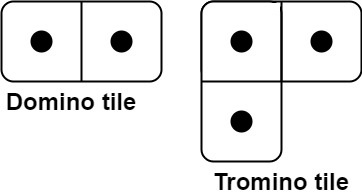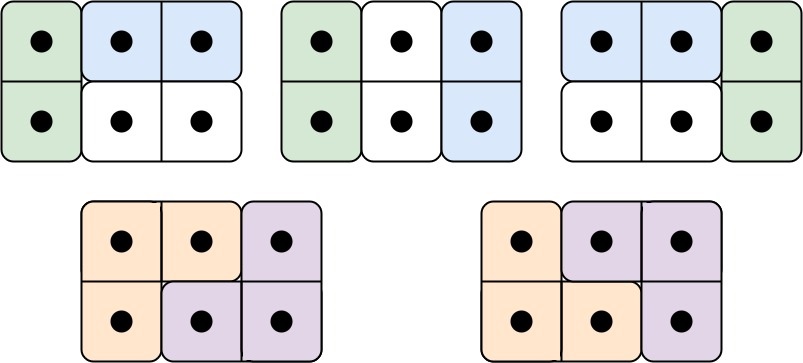790. Domino and Tromino Tiling
Description
You have two types of tiles: a 2 x 1 domino shape and a tromino shape. You may rotate these shapes.

Given an integer n, return the number of ways to tile an 2 x n board. Since the answer may be very large, return it modulo 109 + 7.
In a tiling, every square must be covered by a tile. Two tilings are different if and only if there are two 4-directionally adjacent cells on the board such that exactly one of the tilings has both squares occupied by a tile.
Example 1:

Input: n = 3 Output: 5 Explanation: The five different ways are show above.
Example 2:
Input: n = 1 Output: 1
Constraints:
1 <= n <= 1000
Solutions
Solution: Dynamic Programming
- Time complexity: O(n2)
- Space complexity: O(n2)
JavaScript
js
/**
* @param {number} n
* @return {number}
*/
const numTilings = function (n) {
const MODULO = BigInt(10 ** 9 + 7);
const dp = Array.from({ length: n + 1 }, () => new Array(n + 1).fill(-1));
const putTiling = (col1, col2) => {
if (col1 > n || col2 > n) return 0n;
if (col1 === n && col2 === n) return 1n;
if (dp[col1][col2] !== -1) return dp[col1][col2];
let result = 0n;
if (col1 === col2) {
result = (result + putTiling(col1 + 2, col2 + 2)) % MODULO;
result = (result + putTiling(col1 + 1, col2 + 1)) % MODULO;
result = (result + putTiling(col1 + 2, col2 + 1)) % MODULO;
result = (result + putTiling(col1 + 1, col2 + 2)) % MODULO;
}
if (col1 - col2 === 1) {
result = (result + putTiling(col1, col2 + 2)) % MODULO;
result = (result + putTiling(col1 + 1, col2 + 2)) % MODULO;
}
if (col2 - col1 === 1) {
result = (result + putTiling(col1 + 2, col2)) % MODULO;
result = (result + putTiling(col1 + 2, col2 + 1)) % MODULO;
}
dp[col1][col2] = result;
return result;
};
return Number(putTiling(0, 0));
};